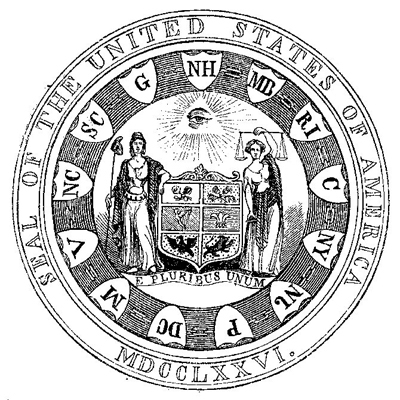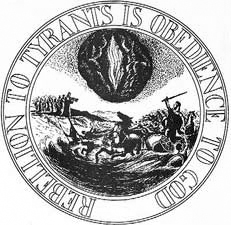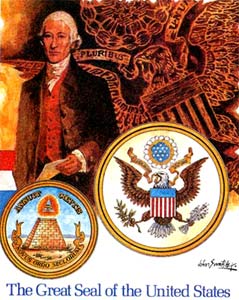It was described thusly:
Shield: "The shield has six Quarters... pointing out the Countries from which these States have been peopled."
Three British:
Rose for England, Thistle for Scotland, Harp for Ireland
Three European:
Fleur-de-lis for France, Belgic Lion for Holland, Imperial Eagle for Germany
The shield is bordered with the initials for "each of the thirteen independent States of America."Crest: "The Eye of Providence in a radiant Triangle whose Glory extends over the Shield and beyond the Figures."
Motto: "E PLURIBUS UNUM"
Evidently the pluribus from which it was considered an unum to come were six countries, which then accounted for most of the inhabitants of the thirteen "independent states." Imagine what it would have to look like now. There had been a brief Swedish colony as well, but they seem to have all gone home after handing the keys over to the Dutch. The Spanish were down in Florida, but Florida wasn't part of the United States yet. No one apparently considered the Indians as being a pluribus contributing to the unum. The Irish at the time were primarily Irish Protestants, a/k/a "Scots-Irish," who were the descendants of the Scotsmen who had been imported to colonize Ulster. That there were Africans as well seems to have escaped their notice.
TOF once described an unpainted painting in his Firestar series, titled E Pluribus. The painting, by one of Belinda's Kids -- "Karen Chong," I think -- replaced each star in the flag with a symbol of a people who had been among the pluribus, pretty much in order of arrival. Each was arranged as nearly star-like as feasible. The Oklahoma flag device for the Indians, an Igbo mask with crosses spears for the Africans, then (in eerie coincidence) the rose, thistle, shamrock, fleur de lie, doppeladler, and so on. The Tao for the Chinese, the Rising Sun for the Japanese, the spinning wheel for the Hindustanis, and so on. One of these days, TOF hopes someone will paint it.
The Reverse of the Seal, suggested by Franklin, was a depiction of Moses on the far bank of the Sea closing the waters upon Pharaoh and his army:
"Pharaoh sitting in an open Chariot, a Crown on his head and a Sword in his hand, passing through the divided Waters of the Red Sea in Pursuit of the Israelites: Rays from a Pillar of Fire in the Cloud, expressive of the divine Presence and Command, beaming on Moses who stands on the shore and extending his hand over the Sea causes it to overwhelm Pharaoh. Motto: "Rebellion to Tyrants is Obedience to God."
That motto was a special favorite of Jefferson. Jefferson's suggestion for the seal was:
The children of Israel in the wilderness, led by a cloud by day and a pillar of fire by night. For the reverse side of the seal: Hengist and Horsa, the two brothers who were the legendary leaders of the first Anglo-Saxon settlers in Britain.which seems a bit more Anglo-oriented than the first. John Adams suggested the following:
The painting known as the "Judgment of Hercules," where the young Hercules must choose to travel either on the flowery path of self-indulgence or ascend the rugged, uphill way of duty to others and honor to himself.But the Committee of Three turned the job over to an heraldic expert, who produced the design described above.
The design was tabled.
Two more committees labored to create a design, neither of which was approved. Then finally, the redoubtable Charles Thomson took things in hand and added elements from the previous three attempts and produced the seal we have today.






The Swedish colony on the Delaware didn't last long, but its legacy on frontier architecture was lasting. The log cabin was introduced to America by their efforts.
ReplyDeleteThose designs are awful, in much the same way that most state seals and state flags are awful -- way too busy, way too fussy. A single strong element is best: an eagle, a pyramid, a star. Nothing that takes a paragraph to describe.
ReplyDeleteThis comment has been removed by the author.
ReplyDeleteSix quarters? Is that some sort of technical usage?
ReplyDeleteYep. "Quarter" is the term in heraldry for the divisions on a shield used to put more than one set of arms on one shield. Though it means "in fourths", most systems don't actually have a limit on the number a shield can have.
DeleteSix quarters? Is that some sort of technical usage?
ReplyDelete